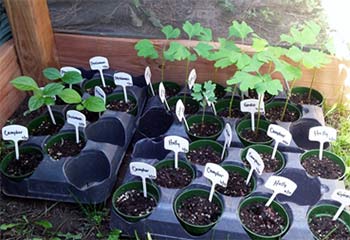Cultivating the Seeds of Peace

Expect the Unexpected
September 15, 2017
What Do You Know About the Father of the Nuclear Age?
October 6, 2017I saw him outside the window on his knees in a small tent-like enclosure. I couldn’t tell what it was or what he was doing there. The contraption looked like a square tent, but with a fine mesh cover protecting him and perhaps something else. What was he doing on the grounds of the Bethe House on Bathtub Row in Los Alamos, New Mexico? I would soon find out.
I had just finished touring the recently renovated historic home where nuclear physicist Hans Bethe lived with his family lived during the development of the bomb in World War II. There was so much to learn and experience within those walls about his work and this secret town. But I would soon expand my understanding of the bomb’s impact in a most unconventional way. When I stepped outside into the stifling August heat, my curiosity drew me to the shady side of the house where the strange structure was located.
Much to my surprise, the man on his knees was bending over something. When he moved slightly, I saw there were about two dozen seedlings that he was carefully tending. Out of the corner of his eye, he saw the puzzled look on my face and encouraged me to come over. As I bent down to peer inside, he explained that he was a volunteer with Los Alamos Historical Society and the caretaker for this property.
Then he proudly revealed the nature of his work in this small enclosed area. His efforts are part of the Los Alamos Japan Project and their new partnership with the Hiroshima Green Legacy project whose mission is to “safeguard and spread worldwide the seeds and saplings of Hiroshima’s atomic bomb survivor trees.” He explained that these seedlings were the second generation descendants from Hiroshima’s atomic bomb survivor trees and that the Los Alamos Historical Society had just received the seeds in June. He thoughtfully pointed out the four varieties, camphor, gingko, holly, and persimmon that were growing and thriving under the careful attention of the master gardeners on this small protected site. Once these seedlings reach maturity and can leave this incubator space, they will be planted on future sites of the museum grounds, including the Robert Oppenheimer home. What a powerful statement those trees will make when they can be viewed and their significance understood in their new surroundings.

I encourage you visit the website http://www.losalamoshistory.org/losalamos_japan_project.html to learn more about this project. You can even see the four seed packets that were recently sent to the museum and are now growing outside the Bethe house. Kudos to all the people at the Los Alamos History Museum, especially Museum Director Judith Stauber for founding this project in 2016 “to build a bridge of understanding between Los Alamos History Museum, the Hiroshima Peace Memorial Museum, and the Nagasaki Atomic Bomb Museum.”
This past August, I had written a blog about the evolution of peace on the anniversary of the bombing of Nagasaki. I saw within my own small community significant signs that our countries had indeed made progress in dealing with the harsh reality of those war years. But these survivor tree seeds are a new twist to that evolution and one most people have yet to hear about. I am so pleased that I had this unexpected opportunity to meet one of the caretakers and learn more about a unique project that reinforces the notion of the evolution of peace. Today, two countries that were once bitter enemies are now working together to cultivate and grow peace, one seed and one tree at a time. As the magnitude of that concept hit me, I thought about ways we might all begin to plant seeds of peace. Perhaps we could start within our own families, expand to our neighbors, communities and eventually our global brothers and sisters. I am still trying to get my arms around this simple but powerful cultural exchange. I am so grateful that we continue to find ways to heal and mend the fences of war and conflict some seventy-two years later.
If you have not had the opportunity to visit Los Alamos, I encourage you to do so. It is a scenic location with vistas that speak of peace and tranquility and not war. It is also a part of a multi-state effort along with Hanford, Washington, and Oak Ridge, Tennessee to preserve, record, and understand our history related to the development of atomic energy. Perhaps you will leave one of these newly created national parks with a new perspective about ways you too can help cultivate seeds of peace.


